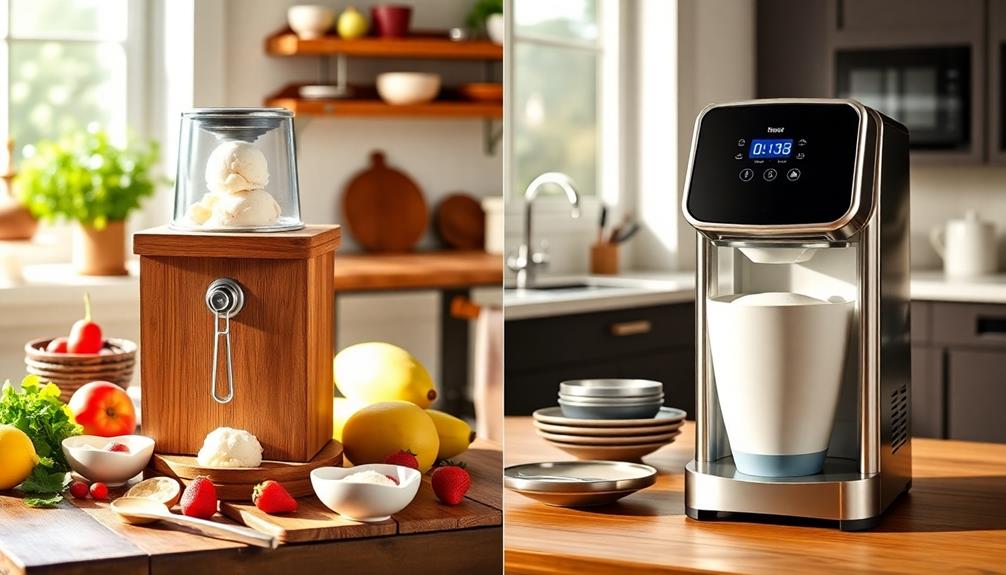To keep your ice cream fresh, opt for flat, shallow plastic containers with tight-fitting lids. These minimize air exposure and prevent freezer burn. Airtight glass containers are great for long-term storage but must be sealed well. Remember to store your ice cream at the back of the freezer, avoiding the door where temperatures fluctuate. Cover the surface of the ice cream with plastic wrap before sealing to combat ice crystals. By following these tips and choosing the right container, you can enjoy creamy, delicious ice cream for longer. There's more useful info to help you find the perfect container!
Key Takeaways
- Airtight Plastic Containers: Ideal for long-term storage, they prevent air exposure and freezer burn, maintaining flavor and texture.
- Flat, Shallow Containers: Promote better freezing and minimize air pockets, ensuring improved texture retention for homemade ice cream.
- Glass Jars: Reusable and easy to clean, they are best for short-term storage but can break easily.
- Metal Containers: Durable and versatile, but must be cleaned properly to avoid flavor transfer and maintain ice cream quality.
- Proper Sealing Techniques: Use plastic wrap or parchment paper before sealing to minimize air exposure and combat ice crystal formation.
Importance of Proper Storage
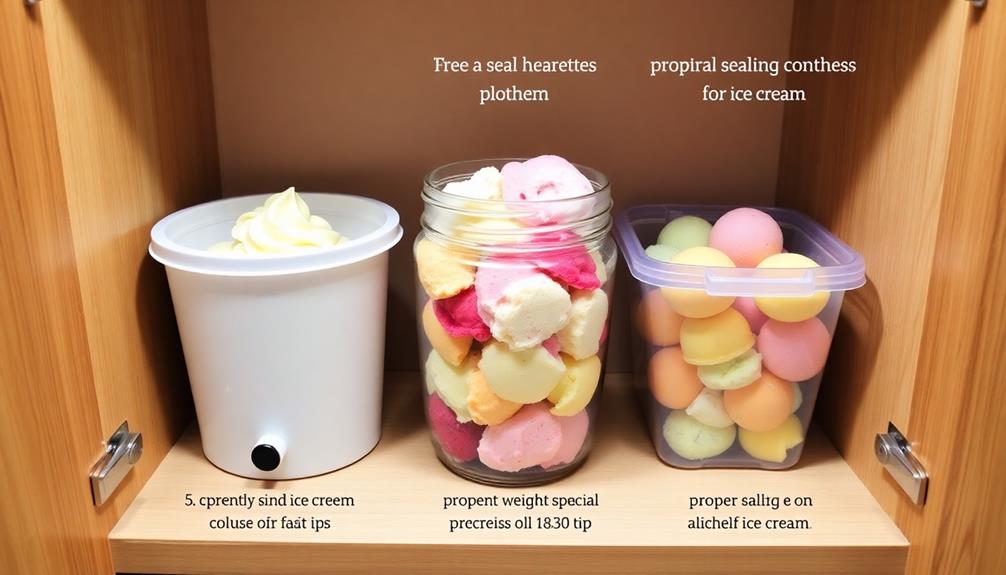
Understanding the importance of proper storage for ice cream is essential for maintaining its delightful flavor and creamy texture. When you store ice cream correctly, you prevent freezer burn and ice crystals from forming, which can ruin your favorite treat. To achieve this, aim for a preferred storage temperature between -20°F (-29°C) and -5°F (-20°C).
Place your ice cream at the back of the freezer, away from the door, to guarantee consistent temperatures. The door's fluctuations can cause melting and refreezing, leading to a less enjoyable experience.
If you've opened a container for homemade ice cream, cover it with plastic wrap or parchment paper before sealing. This minimizes air exposure, prolonging its shelf life.
Regularly monitoring your freezer temperature with a thermometer can help maintain suitable conditions for ice cream storage. This simple step reduces food waste and guarantees your ice cream remains fresh for longer.
Types of Ice Cream Containers

Choosing the right container for storing ice cream can greatly affect its quality and longevity. The ideal storage container will help keep your ice cream fresh while preventing ice crystals from forming.
Here are three common types of ice cream containers to evaluate:
- Plastic Containers: These are the most popular choice due to their durability and food-safe materials. Their tight-fitting lids effectively keep air and moisture out, making them excellent for freezer storage.
- Glass Jars: While these provide a reusable and easy-to-clean option, they're prone to breakage. If you opt for glass, use it for short-term storage rather than long-term.
- Metal Containers: These are durable and come in various sizes, but remember that they can transfer flavors if not cleaned thoroughly. If you love your ice cream's taste, be cautious with this option.
Each type has its pros and cons, but ultimately, you'll want to choose a container that best suits your storage needs.
Best Practices for Storage
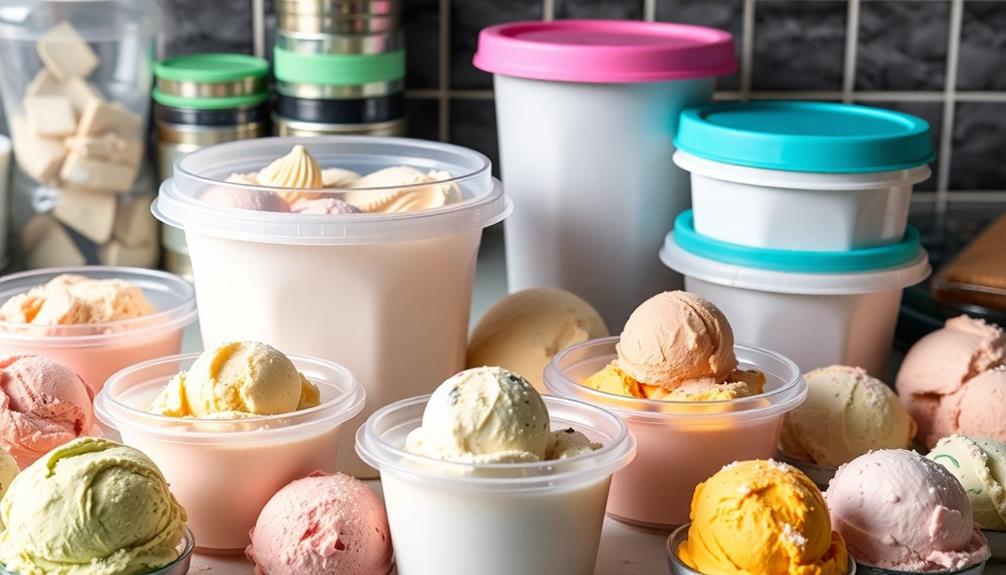
Preserving the freshness of your ice cream requires a few best practices that can make a significant difference. First, keep your freezer temperature between -20°F (-29°C) and 0°F (-18°C) to avoid melting and refreezing, which leads to degraded quality. Use airtight containers, like Starpack Inside Scoop containers, to minimize air exposure and prevent freezer burn.
When storing homemade ice cream, opt for flat, shallow containers. They freeze faster and maintain texture better than round pint-shaped tubs. Also, always store your ice cream at the back of the freezer, where the temperature is more stable, instead of in the door, which experiences fluctuations.
Lastly, for opened containers, cover the surface with plastic wrap or parchment paper to reduce air contact and combat ice crystal formation.
Here's a quick summary of the best practices:
| Best Practices | Tips |
|---|---|
| Container Type | Use airtight, flat containers |
| Freezer Location | Store at the back of the freezer |
| Temperature Control | Maintain -20°F to 0°F |
Signs of Spoilage
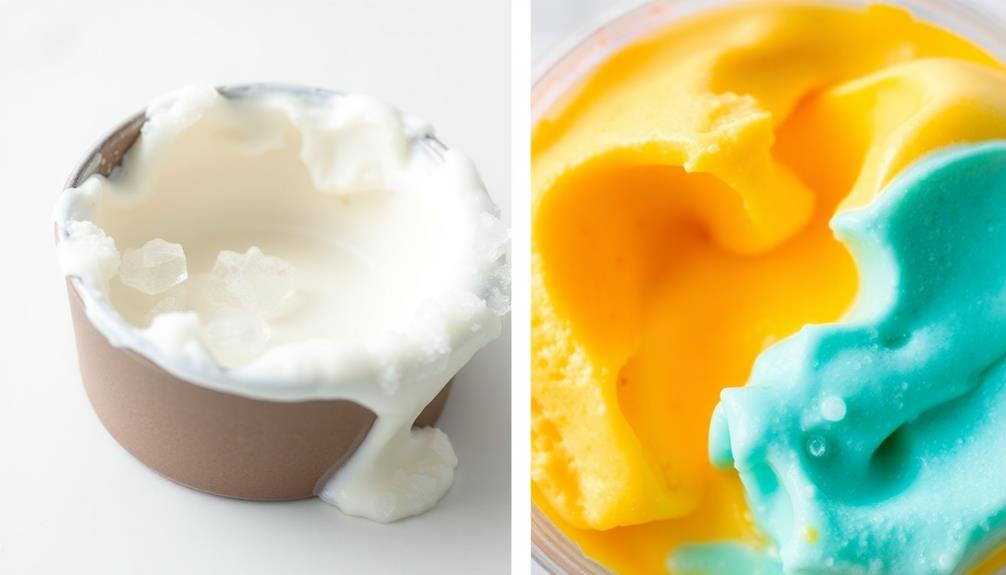
Even with the best storage practices, ice cream can still spoil.
It's essential to recognize the signs of spoilage to guarantee what you're eating is safe. Here are three key indicators that your ice cream may not be safe to eat:
- Off Smells or Flavors: If your ice cream has developed unusual smells or flavors, it's likely a result of prolonged exposure to air or fluctuating temperatures.
- Ice Crystals and Freezer Burn: The presence of ice crystals on the surface suggests freezer burn, which can ruin the texture and flavor. If you notice these crystals, your ice cream's quality has diminished.
- Texture Changes: A grainy or icy texture indicates that your ice cream has been improperly stored or has melted and been refrozen.
This process can lead to spoilage, making it less pleasurable to eat.
Tips for Storing Homemade Ice Cream
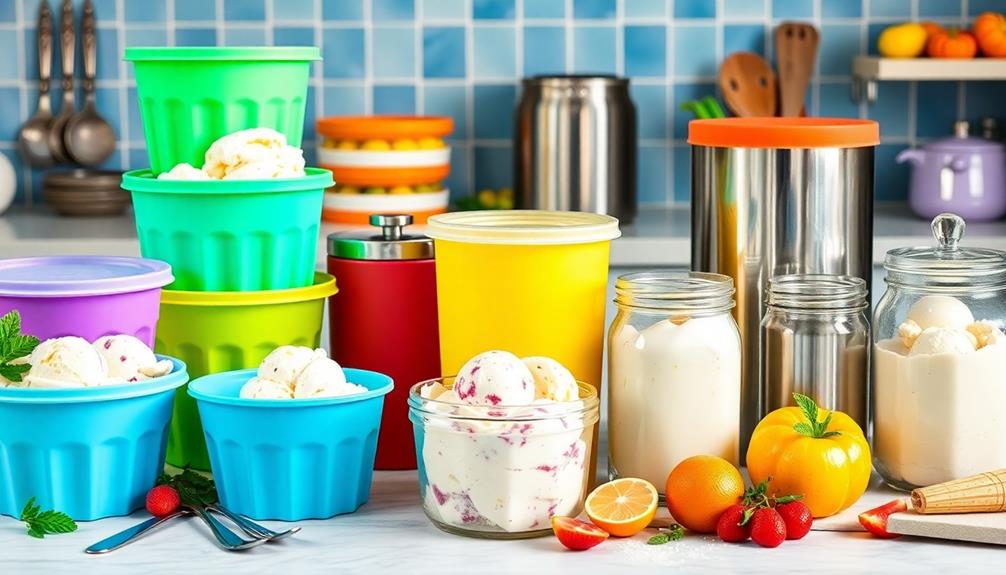
When it comes to storing your homemade ice cream, choosing the right container is key.
You'll want to use flat, shallow plastic containers with tight-fitting lids to maintain the perfect texture and prevent ice crystals.
Don't forget to seal them properly and keep them at a consistent temperature to guarantee your treat stays fresh and delicious.
Ideal Container Types
Choosing the right container is essential for storing homemade ice cream effectively. Using the right type of Ice Cream Freezer Containers can help you maintain peak texture preservation and prevent spoilage.
Here are three ideal container types to take into account:
- Flat, Shallow Plastic Containers: These allow for faster freezing and minimize air pockets that lead to ice crystal formation. Look for containers with frost-free lids to enhance freshness.
- Airtight Glass Containers: While heavier, they're great for long-term storage. Make sure they're airtight to prevent exposure to air, keeping your ice cream creamy and enjoyable.
- Freezer and Microwave Safe Tubs: Opt for containers that can handle temperature fluctuations. This versatility means you can store ice cream and easily reheat leftovers without worrying about damaging your container.
Proper Sealing Techniques
Proper sealing techniques are essential for preserving the delightful texture and flavor of homemade ice cream. To prevent ice crystal formation, always cover the surface of your ice cream with plastic wrap or parchment paper before sealing it with a tight-fitting lid. This extra layer helps keep the air out, which is vital for maintaining that creamy texture you love.
When choosing containers, opt for flat, shallow plastic ones. They allow for faster freezing and improve the overall texture compared to traditional round pint-shaped tubs. Make sure your containers are airtight to minimize air exposure—this will help prevent freezer burn and spoilage.
After scooping out some ice cream, return the container to the freezer promptly. This helps maintain a consistent temperature and quality.
Also, avoid frequently opening the container, as this lets warmer air in, which can degrade the ice cream's texture and freshness.
Temperature Control Strategies
Temperature control is essential for preserving the creamy goodness of your homemade ice cream. To keep your delicious creation fresh and avoid freezer burn, follow these simple strategies:
- Optimal Freezer Temperature: Maintain your freezer between -20°F (-29°C) and 0°F (-18°C). This range helps prevent ice crystal formation, ensuring a smooth texture for your ice cream recipe.
- Ideal Storage Containers: Use flat, shallow plastic containers with tight-fitting lids to store ice cream. This design promotes faster freezing and better texture retention, keeping your ice cream just how you like it.
- Minimize Air Exposure: Before sealing your containers, cover the surface of the ice cream with plastic wrap. This extra layer reduces air exposure, which is key to preventing freezer burn.
Additionally, avoid placing your ice cream in the freezer door, where temperature fluctuations are common. Instead, store ice cream at the back of the freezer.
Always return it promptly after scooping to maintain a consistent temperature, preventing melting and refreezing that can ruin its texture.
Following these temperature control strategies will keep your homemade ice cream tasting delightful!
Customer Reviews and Recommendations
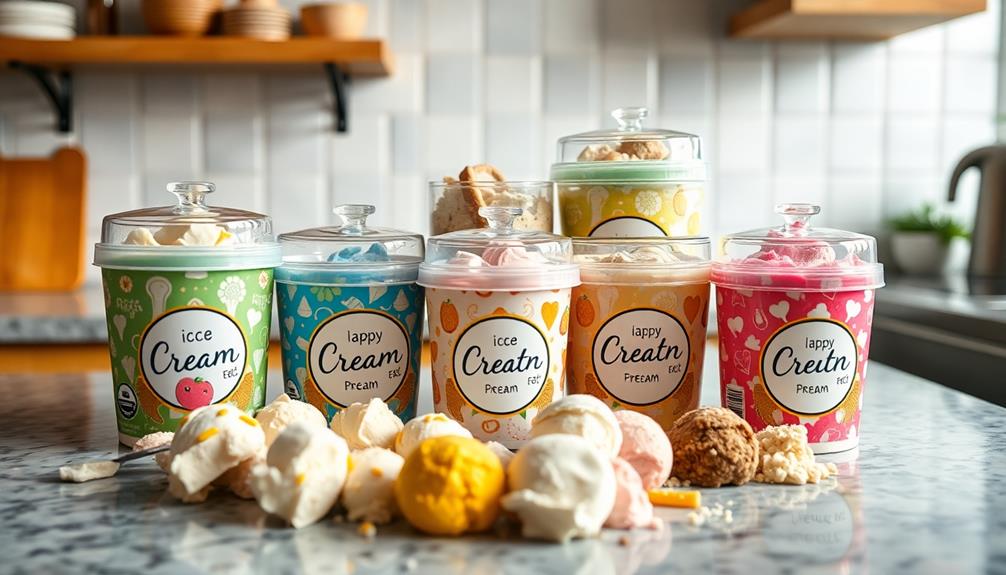
When it comes to ice cream storage, customer reviews highlight the effectiveness of the Starpack Inside Scoop Ice Cream Storage Containers. With an impressive average rating of 4.6 out of 5 stars from about 3,780 reviews, it's clear that these containers deliver on customer satisfaction.
Users rave about the tight-sealing lids that effectively prevent freezer burn and ice crystals, ensuring your ice cream stays fresh and delicious. Many reviewers appreciate the efficient design of these containers, noting their long, slim shape that fits perfectly in freezer doors.
This design not only optimizes space but also makes scooping a breeze. Customers also commend the durable construction of the containers, which can withstand aggressive scooping without cracking, enhancing their longevity.
However, it's important to note that some feedback points out occasional durability issues with the inner layer and that the lids mightn't secure as tightly as desired.
While these concerns exist, the overall positive reviews demonstrate that the Starpack containers are a reliable choice for keeping your ice cream fresh and enjoyable. If you're serious about your ice cream, these containers are definitely worth considering.
Frequently Asked Questions
Which Container Will Keep Ice Cream Cold Longer?
To keep ice cream cold longer, choose containers with double-wall insulation and airtight lids. Flat, shallow designs enhance freezing efficiency, while high-quality materials guarantee better thermal insulation, helping maintain that perfect creamy texture you love.
What Is the Best Container to Freeze Ice Cream?
You'd think the fanciest container would freeze ice cream best, right? In reality, shallow, airtight containers are your top choice. They let air circulate, freeze faster, and keep your ice cream's texture delightful.
How Do You Keep Ice Cream Fresh?
To keep ice cream fresh, maintain a consistent freezer temperature, store it at the back, and use airtight containers. Cover with plastic wrap before sealing and return it promptly after scooping to preserve quality.
Is It Better to Store Ice Cream in Glass or Plastic?
Did you know that glass containers can reduce flavor contamination by up to 50%? When deciding between glass and plastic, consider your priorities; glass minimizes freezer burn, while plastic is often more affordable and durable. Choose wisely!
Conclusion
In the world of ice cream, the right container is your best friend, ensuring every scoop remains a creamy delight. By choosing high-quality storage options and following best practices, you can keep your frozen treats fresher for longer. Watch for signs of spoilage, especially with homemade varieties, and enjoy the sweet rewards of your careful storage efforts. Remember, the key to a perfect scoop lies in the container you choose—don't let your ice cream dreams melt away!

